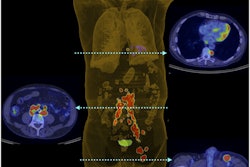Dear AuntMinnie Member,
The Medicare Payment Advisory Commission (MedPAC) is no friend of radiology, it would seem. Despite recent studies pointing to a sharp slowdown in medical imaging spending over the last few years, MedPAC has released yet another report that harps on the supposedly strong growth of imaging from 2000 to 2013.
The new report found that imaging volume per Medicare beneficiary grew 71% from 2000 to 2013, outstripping growth in all other MedPAC categories but one. Also, imaging and cancer screening studies made up most of what MedPAC called "low-value care" in 2012.
But a different picture emerges if you look more closely at the numbers. The MedPAC data also show that imaging volume actually peaked in 2009, and since then has dropped much more precipitously than any other segment tracked by the report.
This would all be an academic argument if it weren't for the influence that MedPAC plays on future policy decisions made by the U.S. Centers for Medicare and Medicaid Services (CMS), which administers Medicare. CMS often pays close attention to MedPAC recommendations; the question is whether the new data will convince the agency to continue putting pressure on payment rates for medical imaging.
Learn more by clicking here, or visit our Imaging Leaders Community at leaders.auntminnie.com.
Analyzing IBM's Merge buy
When IT giant IBM announced its intention to acquire imaging informatics firm Merge Healthcare earlier this month, it sparked a raft of speculation on what the deal meant, both for IBM's future in the healthcare market and radiology in general. Fortunately, senior editor Erik L. Ridley was able to speak with Shahram Ebadollahi, PhD, chief scientific officer for IBM's fledgling Watson Health unit, to get additional insight into the company's intentions.
IBM plans to combine Merge with other recent acquisitions into its Watson Health unit, a recently formed division based around the company's Watson artificial intelligence technology. The company sees Watson as a step toward the creation of a technology platform that will enable the analysis of massive amounts of patient data -- the realization of the big data dream in healthcare.
IBM believes that its computing and data analytics technology could begin filtering out to Merge customers as soon as 2016. Next would be large-scale data analysis that has the potential to impact healthcare on a more widespread basis.
Read more by clicking here, or visit our Imaging Informatics Community at informatics.auntminnie.com.
The IDEAS study
Finally, visit our Molecular Imaging Community for a profile of the Imaging Dementia -- Evidence for Amyloid Scanning (IDEAS) study, an ambitious $100 million research study designed to investigate the potential of amyloid PET scanning in shedding light on neurological diseases such as Alzheimer's, dementia, and cognitive impairment.
Features editor Wayne Forrest interviewed several of the main investigators of the IDEAS study for an article you can read by clicking here, or by going to the community at molecular.auntminnie.com.



















